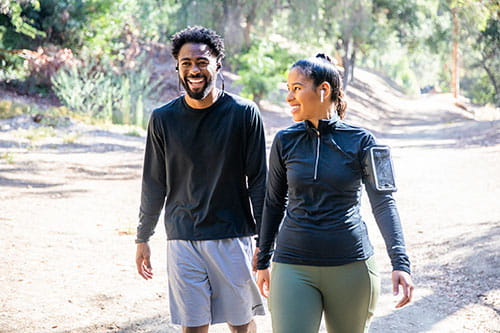Walk your way to better health

Walking is one of the simplest ways to get active and stay active. With each step you take, you travel further down the path to a healthier lifestyle.
For most people, it’s a safe and low- or no-cost activity that’s easy to stick with long term. And it doesn’t require special skills or equipment.
Brisk walking (3 to 4 miles per hour) is an aerobic activity that conditions your heart and lungs. And like other regular physical activities, brisk walking benefits the body and the brain and can help you feel better.
As for feeling better, regular physical activity can give you more energy, increase your resistance to fatigue, improve your self-image, help you relax and sleep better and reduce symptoms of depression.
You can be healthier because regular physical activity can tone your muscles and improve your bone health. It can also help lower your blood pressure and cholesterol and help you manage your weight.
Aim to do at least 150 minutes of moderate-intensity physical activity, such as brisk walking, a week. You can start walking 10 minutes at a time and work your way up to 30 minutes on most days of the week to reach this goal.
Here are some tips to plan, start and stick with your walking program:
- Choose a time of day that works best for you. Then stick with that time. If you don’t have a full 30 minutes to walk at once, that’s OK. Take three 10-minute walks or two 15-minute walks.
- Find a place. To maintain your walking program year-round, choose a place where you can walk all the time. For outdoor walking, find a course with a smooth surface away from traffic. If you’d rather walk indoors, try a track at a school or recreation center, or walk inside a shopping mall.
- Wherever you walk, be sure it’s safe and well lit. If you walk outside after dark, wear a reflective device or reflective clothing and carry a flashlight.
- Find a partner. Walking with someone can be more fun and help you stick to your program. Your partner should be able to keep the same schedule and walk at the same pace as you.
- Pick the right gear. Wear shoes with thick, flexible soles that cushion the bottom of your feet and absorb shock for the rest of your body. If you walk outside during the winter, layer your clothing to keep out the cold and wind. In the summer, wear lightweight or moisture-wicking clothing that lets sweat evaporate.
- Track your progress. A pedometer or physical activity tracking device that you can wear on your wrist can track your daily progress. You can also download an app on your smartphone to track your miles. This could help you stay motivated!
- Build it in. Build walking into your schedule and lifestyle so it doesn’t feel like a chore. Schedule a walking meeting with co-workers and you all will benefit. Take a family walk after dinner to fit in family time and exercise.
- Give it time. It can take a while for a new behavior to become a habit, so give yourself time to get into a regular routine. Once it becomes a habit, you’ll notice when you aren’t doing it.
- Reward yourself. This may include buying new workout clothes, shoes or a fitness tracker. But you don’t have to spend money. You could watch a movie, read a book or have a game night with family or friends.
It’s not all or nothing — it’s step by step. So take your first steps today to start walking your way to better health.






